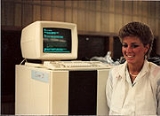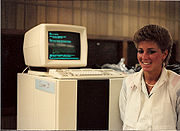
PRIMOS
Encyclopedia

Operating system
An operating system is a set of programs that manage computer hardware resources and provide common services for application software. The operating system is the most important type of system software in a computer system...
developed during the 1970s by Prime Computer
Prime Computer
Prime Computer, Inc. was a Natick, Massachusetts-based producer of minicomputers from 1972 until 1992. The alternative spellings "PR1ME" and "PR1ME Computer" were used as brand names or logos by the company.-Founders:...
for its minicomputer
Minicomputer
A minicomputer is a class of multi-user computers that lies in the middle range of the computing spectrum, in between the largest multi-user systems and the smallest single-user systems...
systems. It rapidly gained popularity and by the mid-1980s was a serious contender as a mainline minicomputer operating system. With the advent of PCs
Personal computer
A personal computer is any general-purpose computer whose size, capabilities, and original sales price make it useful for individuals, and which is intended to be operated directly by an end-user with no intervening computer operator...
and the decline of the minicomputer industry Prime was forced out of the market in the early 1990s.
Prime Computer is also sometimes referred to as "Pr1me" and PRIMOS as "Pr1mos". (Note: Actual system documentation of the day displays the alternate spelling as "PR1ME" or PR1MOS", which avoids the unfortunate visual "hump" that appears in the lower-case rendition due to the height of the "1").
Very early versions of PRIMOS (revision 6) were originally called DOS (PRIMOS 2) and later DOSVM (PRIMOS 3) but PRIMOS is the name that stuck. There were many major releases of PRIMOS. The last official revision (24.0.0.R52) was released July 3, 1997. By this time, a company called Peritus (which employed a number of ex-Prime engineers) was maintaining PRIMOS. Prime also offered a customizable real-time OS called RTOS.
An interesting feature of PRIMOS was that it, like UNIX
Unix
Unix is a multitasking, multi-user computer operating system originally developed in 1969 by a group of AT&T employees at Bell Labs, including Ken Thompson, Dennis Ritchie, Brian Kernighan, Douglas McIlroy, and Joe Ossanna...
, was largely written in a high level language (with callable assembly language
Assembly language
An assembly language is a low-level programming language for computers, microprocessors, microcontrollers, and other programmable devices. It implements a symbolic representation of the machine codes and other constants needed to program a given CPU architecture...
library functions available). At first, this language was FORTRAN
Fortran
Fortran is a general-purpose, procedural, imperative programming language that is especially suited to numeric computation and scientific computing...
IV, which was an odd choice from a pure computer science
Computer science
Computer science or computing science is the study of the theoretical foundations of information and computation and of practical techniques for their implementation and application in computer systems...
standpoint: no pointers, no if-then-else, no native string type, etc. FORTRAN was, however, the language most known to engineers, and engineers were a big market for Prime in their early years. Later, around version 18, a version of PL/1, called PL/P
PL/P
The PL/P programming language is a medium-level language developed by Prime Computer to serve as their second primary operating system programming language after Fortran IV....
, became the high level language of choice within PRIMOS. The source code to PRIMOS was available to customers and, thanks to FORTRAN and PL/P, customers could reasonably modify PRIMOS as needed.
Because Prime's hardware did not perform byte addressing, there was no impetus to create a C
C (programming language)
C is a general-purpose computer programming language developed between 1969 and 1973 by Dennis Ritchie at the Bell Telephone Laboratories for use with the Unix operating system....
compiler. Late models of the hardware were eventually modified to support "I-mode", and programs compiled in C.
Legend has it that the unusual choice of FORTRAN for the OS programming language had to do with its history. Allegedly, the founders of Prime had worked for Honeywell
Honeywell
Honeywell International, Inc. is a major conglomerate company that produces a variety of consumer products, engineering services, and aerospace systems for a wide variety of customers, from private consumers to major corporations and governments....
on a NASA
NASA
The National Aeronautics and Space Administration is the agency of the United States government that is responsible for the nation's civilian space program and for aeronautics and aerospace research...
project. However, Honeywell at that time was uninterested in minicomputers, so they left and founded Prime, taking the code with them. They developed hardware optimized to run FORTRAN, including machine instructions that directly implemented FORTRAN's distinctive 3-way branch operation.
In the versions of PRIMOS ca. 1977 and later, the filesystem included a distinctive construct known as the Segment Directory. Unlike more traditional directories, the files anchored in a segment directory were located using an integer index, effectively reducing searches of the directory to a simple hash function. Segment Directories were used in their Keyed-Index/Direct Access (KI/DA) file access system and in later versions of the system loader.
From Revision 19, major portions of PRIMOS were written in the languages SPL and Modula-2
Modula-2
Modula-2 is a computer programming language designed and developed between 1977 and 1980 by Niklaus Wirth at ETH Zurich as a revision of Pascal to serve as the sole programming language for the operating system and application software for the personal workstation Lilith...
, the usage of the assembler PMA (Prime Macro Assembler), FORTRAN IV and PL/P declined considerably around this time. Programs were guaranteed to run on all current Prime processors (subject to sufficient resources being available), as well as all subsequent Prime processors.
Late versions of PRIMOS included a scripting language, CPL (Command Processing Language) that ESRI
ESRI
Esri is a software development and services company providing Geographic Information System software and geodatabase management applications. The headquarters of Esri is in Redlands, California....
used as a basis for its platform-independent scripting languages AML (for ArcInfo
ArcInfo
ArcInfo is a full-featured geographic information system produced by Esri, and is the highest level of licensing in the ArcGIS Desktop product line. It was originally a command-line based system...
) and SML (PC-ARC/INFO
ArcInfo
ArcInfo is a full-featured geographic information system produced by Esri, and is the highest level of licensing in the ArcGIS Desktop product line. It was originally a command-line based system...
).
The PRIMOS character set was basically ASCII
ASCII
The American Standard Code for Information Interchange is a character-encoding scheme based on the ordering of the English alphabet. ASCII codes represent text in computers, communications equipment, and other devices that use text...
but with the 8th bit inverted. The original 7-bit standard for ASCII left the 8th bit unspecified, but on the commonly available Teletype Model 33 ASR, the bit was customarily set to 1, and this became Prime's standard. This is vital to realize when transferring data from PRIMOS to almost any other system.
PRIMOS systems are becoming rare but as of 2006 there are still some in production, including a number of Primes running a modified version of PRIMOS in the United Kingdom
United Kingdom
The United Kingdom of Great Britain and Northern IrelandIn the United Kingdom and Dependencies, other languages have been officially recognised as legitimate autochthonous languages under the European Charter for Regional or Minority Languages...
, supporting a large corporate telecommunications network.
External links
- Usenet post of Jim Wilcoxson about the Prime 50-series emulator he created, running PRIMOS 19.2 (7th April 2007).

